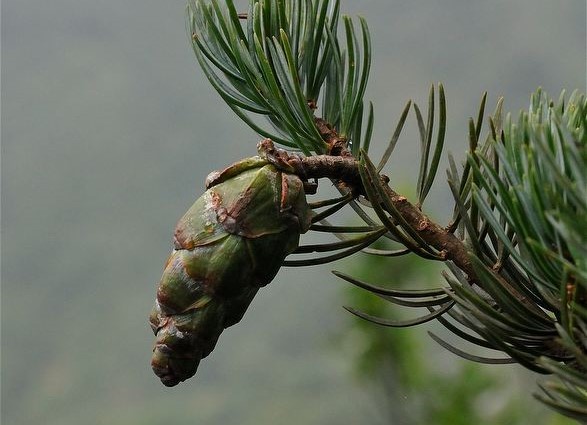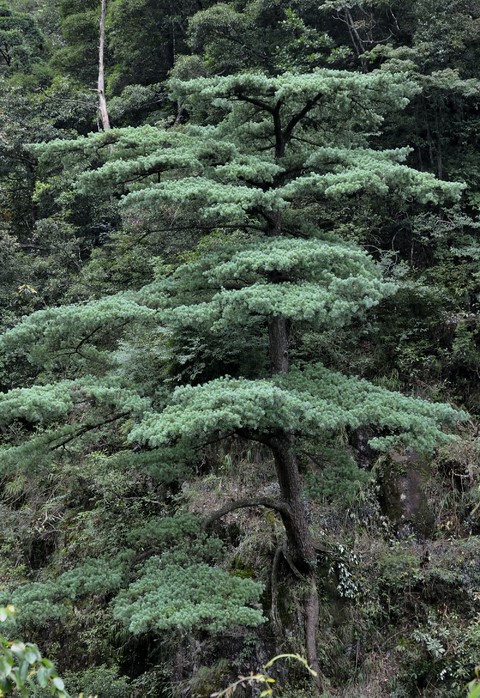subgenus Strobus (Lemmon), section Quinquefoliae (Duhamel), subsection Strobus (Loudon).
Pinus fenzliana, first described in 1931 by Heinrich Raphael Eduard Handel-Mazzetti (1882-1940), is commonly known as Hainan white pine, as well as æµ·Š—äº”é’ˆæ¾ (hainan wuzhensong), literally, "Hainan 5-needle pine" in the Chinese language. This species honors Austrian botanist, Eduard Fenzl (1808-1879), Professor of Botany and Director of the Imperial Botanical Cabinet, a member of the Vienna Academy of Sciences, and Vice-President of the Vienna Horticultural Society.
Some authors list this pine as a specific variety of P. armandii, i.e. P. armandii var. fenzliana.
Description. Hainan white pine is an evergreen coniferous species of tree that grows to mature heights of 150 feet (50 m) with a trunk up to 40 inches (100 cm) in diameter, measured at breast height.
- Bark is dark brown or gray-brown, flaking.
- Branchlets are pale brown, drying to a dark red-brown, rarely glaucous. They are slender, glabrous, and longitudinally furrowed.
- Foliar buds are cylindric-conical or ovoid, and slightly resinous.
- Leaves (needles) are borne in bundles of 5 per fascicle, slender. They are triangular in cross section, measure 2 to 7.2 inches (5 - 18 cm) long and 0.02 to 0.027 (0.5-0.7 mm) wide. Needles are flexible, with 1 vascular bundle; and 3 resin canals, 2 marginal and 1 medial.
- Seed cones are solitary or borne in clusters of 2 to 4 at the base of branchlets, growing on a 0.4 to 0.8 inch (1 - 2 cm) long peduncle. Cones are long and green, maturing to yellow-brown; narrowly ovoid, ellipsoid-ovoid, or cylindric-ellipsoid shaped. They are usually resinous and dehiscent, measuring 2.4 to 5.6 inches (6 - 14 cm) long and 1.2 to 1.8 inches (3 - 6 cm) wide.
- Seed scales are almost cuneate or oblong-obovoid, 0.8 to 1 inch (2 - 2.5 cm) long and 0.6 to 0.8 inch (1.5 - 2 cm) wide at middle of cone. Apophyses have a broadly subrhombic outline with an obviously reflexed distal margin, and a thickened apex.
- Seeds are chestnut- or pale brown, and obovoid-ellipsoid shaped, measuring 0.32 to 0.6 inch (0.8 - 1.5 cm) long and 0.2 to 0.32 inch (5 - 8 mm) wide. The seed coat is thin. The attached wing is rudimentary, measuring 0.08 to 0.16 inch (2 - 4 mm) long or much shorter. Pollination takes place in April, seed maturity is in October to November of the second year.
Pinus armandii is similar, but has a thick, hard seed coats; seeds are wingless or ridged along abaxial margin; apophyses are not or slightly reflexed at their margins; and it is widely distributed in China.
P. fenzeliana has a thin, easily breakable seed coats; seeds have a rudimentary wing 0.08 to 0.028 inch (2 - 7 mm) long. The apophyses obviously reflexed at their margin; and it is only native to southern China.
Distribution. This species is native to Vietnam and China - southwestern Anhui, Guangxi, central and northern Guizhou, Hainan, southeastern Henan, eastern Hubei, and southeastern Sichuan provinces, growing at elevations of 2,800 to 5,200 feet (900 -1600 m) above sea level.
Hardy to USDA Zone 9 - cold hardiness limit between 20° and 30°F (-6.6° and -1.1°C).

